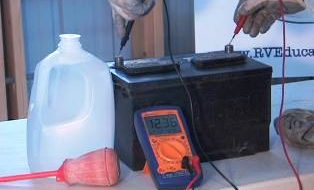Testing, charging and properly storing your deep cycle batteries will prolong their life span. There are a couple of different ways to check your batteries state of charge. You can measure the voltage with a digital voltmeter or check the specific gravity with a hydrometer. Testing the specific gravity is the preferred method but measuring voltage has its advantages. If you have sealed batteries your only choice is to measure voltage and measuring voltage can give you a quick picture of the batteries depth of discharge so you know when they need to be recharged.
If the battery state-of-charge is below 70% the battery needs to be recharged before you test it. The battery should not be tested if it has been charged or discharged in the last 6 hours and preferably 24 hours. This is called an open circuit voltage test. To measure the voltage you need a good digital voltmeter. Using the DC voltmeter check the voltage and compare it to this chart.
|
% State Of Charge |
Specific Gravity Corrected 80 F |
Open Circuit 12-Volt |
Open Circuit 6-Volt |
|
100 |
1.277 |
12.73 |
6.37 |
|
90 |
1.258 |
12.62 |
6.31 |
|
80 |
1.238 |
12.50 |
6.25 |
|
70 |
1.217 |
12.37 |
6.19 |
|
60 |
1.195 |
12.24 |
6.12 |
|
50 |
1.172 |
12.10 |
6.05 |
|
40 |
1.148 |
11.96 |
5.98 |
|
30 |
1.124 |
11.81 |
5.91 |
|
Discharged |
1.120 |
11.80 |
5.90 |
Whenever possible you should avoid discharging a battery below 40%. Battery readings that are off of this chart indicate the battery was left discharged too long or the battery may have a bad cell.
The preferred method for testing the battery’s state of charge is to check the specific gravity reading of each cell. You can purchase a hydrometer at an auto parts store for about ten dollars. The electrolyte is a solution of acid and water so you need to wear goggles and gloves and avoid skin contact. Remove the vent caps and check the electrolyte levels. There has to be enough electrolyte in the cell for the hydrometer to pick it up. If you have to add any water you’ll have to charge the battery and let it sit for at least six hours before testing. Fill and drain the hydrometer at least twice in each cell before taking a sample. Take the reading and record it, then drain it back into the cell. Test all of the cells and replace the vent caps. If your hydrometer does not compensate for temperature you must correct the readings to 80 degrees F. Add .004 for every 10 degrees above 80 degrees F and subtract .004 for every 10 degrees below 80 degrees F. Compare the readings to the chart.
The battery might be bad:
- If there is a .050 or more difference in the specific gravity reading between the highest and lowest cell, you have a weak or dead cell(s)
- The battery will not recharge to a 75% or more state-of-charge level.
Remember, what you take out of your batteries must be put back in and if it’s not done in a timely manner the battery sulfates and can be permanently damaged. Single stage RV converter chargers have a fixed output voltage around 13.6 volts and over time will boil off the electrolyte in the battery. You need a three stage charger that can provide a bulk charge then an absorption charge and finally a float charge. There are RV converter chargers on the market that will do this.
If you purchase a multi-stage battery charger you need to know the charging current limitations of the battery being charged. For proper charging always follow the instructions that come with the battery charger. Make sure you match the charger to the battery manufacturer’s recommended charging voltages or match the batteries to the charger capability. Batteries should be charged as soon as possible after each period of use or whenever they reach a 70% state of charge or below. The batteries should only be charged in a well ventilated area and keep any sparks and open flames away from a battery being charged. Check the electrolyte levels before and after charging batteries.
If you put your RV in storage it is a good idea to remove the batteries and put them in storage too. This is quite simple to do. When you’re removing the battery always remember to remove the negative terminal first. Clean the batteries with a 50/50 mixture of baking soda and water if necessary. Check the electrolyte level and add distilled water if necessary. Test the battery state of charge and charge any batteries that are at or below 70%. A discharged or partially charged battery will freeze much faster than a charged battery. Store the batteries in a cool dry place but not where they could freeze. Batteries in storage will lose a percentage of its charge. Check the state of charge every month and charge batteries that are at or below 70% state of charge.
Happy Camping,
Mark J. Polk





Del
Hi We have a 2002 36′ class A Southwind with a Ford chasis, V10 and love it. When reading my digital battery voltage readout in the house info panel. The house battery is charging fine but the truck battery has stopped charging while we are plugged in. I do start the truck once a week but I fear I am not charging it fully and I may be wrecking a perfectly good top of the line battery that is only 2 years old. Is there some kind of a intercept or relay or protector to the truck battery from the plug in charger that may be malfunctioning. Thank you Del Wiebe
Jack Tompkins
I don’t see many 6 volt battery chargers around and I have 2 6 volt batteries in a series for the coach batteries. Can they be charged with a 12 volt charger while left connected in a series?
Thanks
Jane Maurice
For the voltage monitor in the RV control center, which always shows “Good” battery status — what can be done (easily, hopefully) such as a load on its circuit, for the monitor to display correct battery status?
Loren A. Jacobs
We inherited a 1991 Fleetwood 32′ MH from my father-in-law. For coach power it has two 6 Volt batteries, wired in series. I am wondering why? Is there any possibility that the two 6’s would provide steadier/longer lasting power than one 12? Why not have two 12s in the same space that the 6’s require? What am I missing?
Papasnake37
Mark Polk
Steve
If your converter charger is a 3 stage charger capable of providing a bulk charge then an absorption charge and finally a float charge it should normally keep the battery topped off okay.
The problem I see is you mentioned the coach battery is a gell cell battery. There are several disadvantages to gell cell batteries for RV applications. Most importantly they must be charged at a slower rate and a lower voltage than flooded cell batteries. Any overcharging can cause permanent damage to the cells.
I would recommend the same thing I did to van parton, to us a product like the Battery Minder http://www.vdcelectronics.com/camping.htm when the unit is being stored. It is safe for use with gell cell batteries and should solve the problem of the battery discharging.
Mark Polk
van parton
It’s quite common for RV batteries to discharge while the RV is in storage or in between trips. There are numerous parasitic loads, electronic devices and equipment in your RV that can drain the coach battery when you’re not using the RV. Some examples are; the TV antenna booster when it is left on, the LP gas leak detector, clocks in radios, or just leaving a 12-volt light on by accident.
It’s also quite possible that your battery isn’t fully charged and these small loads discharge the battery even quicker. Changing to two 6 volt batteries probably won’t solve this problem and keep in mind that series wiring only makes the 6 volt batteries produce the required 12 volts for the system.
If you can’t determine what is draining the battery I would recommend disconnecting the battery when the unit is in storage. Always disconnect the negative terminal first and then the positive.
What I do to keep my batteries fully charged when not in use is to use a product called the Battery Minder, http://www.vdcelectronics.com/camping.htm It charges, maintains and conditions the batteries and will never overcharge the batteries.
Mark Berg
My motor-home is stored for winter in a storage lot without shorepower. I have had no problems maintaining 2 x 6V T-105’s by going out once a month and starting V10 engine, and running generator to recharge batteries. Batteries are original from 2003.
I know deepcycle batteries have a certain number of times they can be recharged. Since many people on RV.Net meantion batteries going down in less than a week, has anyone ever come up with how many charge cycles the batteries will go through per month while stored on shore power.
I would think batteries will last longer if disconnected while stored, and reconnected for charging once a month either on shore-power, or by generater.
Mark
Steve White
This one has concerned me for some time. I have a two battery system – one for the chassis and another for the coach. The coach battery is a sealed deep cycle 12V gell cell and if I leave DC power on in a low state (everything off except the monitoring systems) the coach battery will discharge in about 3-4 days. Consequently, I have made it a practice to connect AC power to the utility panel whenever the RV is parked in our driveway between trips. Is there anything wrong with this? Thanks, Steve
van parton
I have about a 1 year old 12 volt battery. it seems that if i don’t use it for a few days that it goes dead. would it be better for me to change over to 2 six volt batteries and wire them in series?